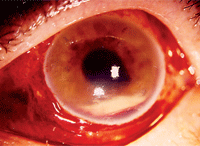 Q: I have a post-op cataract patient who looked good at the one-day visit but called me on day five to report that his vision was getting worse and his eye was beginning to hurt. When do I worry about endophthalmitis?
Q: I have a post-op cataract patient who looked good at the one-day visit but called me on day five to report that his vision was getting worse and his eye was beginning to hurt. When do I worry about endophthalmitis?
“Whenever a patient calls complaining about blurry vision and pain after cataract surgery—whether one day or one month post-op—you must always consider the possibility of an intraocular infection,” says Steven E. Holbrook, O.D., of the Eye Center of Southern Indiana, in Bloomington.
At times, eye care providers may have difficulty distinguishing between the signs of endophthalmitis (whose reported incidence ranges between 0.04% and 0.345% after cataract surgery) and those of an exaggerated inflammatory response.1,2 “Having treated many patients during an outbreak of toxic anterior segment syndrome several years ago, I learned how difficult it can be to determine the etiology of postoperative inflammation,” Dr. Holbrook says.3
Q: What is endophthalmitis? What are its typical signs and symptoms?

Endophthalmitis: The classic example of ‘It’s not rare if it’s in your chair.’
Endophthalmitis presents as a severe inflammatory reaction of the anterior and posterior segment caused by the introduction of bacteria (most commonly coagulase negative Staphylococcus) into the eye during cataract surgery.4 “Risk factors for endophthalmitis include the patient’s age, poor wound construction and intraoperative complications,” Dr. Holbrook says.
Signs can include blurry vision, moderate to severe pain, swollen eyelids, redness, ocular ache, photophobia and vitreous floaters. “These symptoms can appear any time between five days (the mean time of onset) and several months after cataract surgery,” Dr. Holbrook says.
Q: How should I work up patients with suspected endophthalmitis? When should I treat patients in-house vs. referring them?
The most reliable way to differentiate between benign inflammation and endophthalmitis, Dr. Holbrook says, is to examine the vitreous.
“Perform a slit-lamp and dilated fundus examination to determine the degree of inflammation and whether it extends to the vitreous cavity,” he says. “If the patient has a combination of pain, swollen eyelids and vitreous cells, I immediately refer him or her.” Notify the cataract surgeon immediately, but the patient ultimately needs to be seen by a retinal surgeon for a vitreous tap/culture and treatment with intravitreous antibiotics.
Intravitreous injections for endophthalmitis often, but not always, include a steroid to minimize vitreous inflammation, Dr. Holbrook says.
“If the patient’s vision is good and the examination reveals an externally quiet eye with signs of hypopyon or exaggerated cells in the anterior chamber, I would consider starting them on a fourth-generation fluoroquinolone every hour combined with prednisolone acetate (also q1h) or Durezol (difluprednate 0.05%, Alcon) every four to six hours,” Dr. Holbrook says.
“If I have any doubt about the presence of endophthalmitis, I will always err on the side of caution, which in a primary care optometric setting means sending the patient back to the operating surgeon’s office immediately,” he says. Call the surgeon, make the appointment, and carefully record everything you did in the chart.
1. Barry P, Seal D, Gettinby G, et al. ESCRS study of prophylaxis of postoperative endophthalmitis after cataract surgery: preliminary report of principal results from a European multicenter study. J Cataract Refract Surg. 2006 May;32(5):709.
2. Miller JJ, Scott IU, Flynn HW Jr. Acute-onset endophthalmitis after cataract surgery (2000-2004): incidence, clinical settings, and visual acuity outcomes after treatment. Am J Ophthalmol. 2005 Jun;139(6):1097-8.
3. Hellinger WC, Hasan SA, Bacalis LP, et al. Outbreak of toxic anterior segment syndrome following cataract surgery associated with impurities in autoclave steam moisture. Infect Control Hosp Epidemiol. 2006 Mar;27(3):294-8.
4. Johnson MW, Doft BH, Kelsey SF, et al. The Endophthalmitis Vitrectomy Study. Relationship between clinical presentation and microbiologic spectrum. Ophthalmology. 1997 Feb;104(2):261-72.

